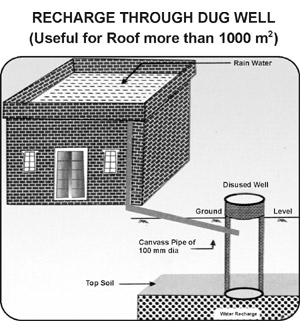Dec 24, 2025
Dec 24, 2025
(Page 2)
Subsurface Techniques
 The surface techniques involve diverting water to surface structures that permit smooth infiltration down to depths. On the other hand the subsurface techniques use structures that reach up to aquifer level.
The surface techniques involve diverting water to surface structures that permit smooth infiltration down to depths. On the other hand the subsurface techniques use structures that reach up to aquifer level.
Injection Well
One of the costly but efficient ways to enrich the aquifers with water is through Injection Wells. These are in-fact tubewells and during monsoon water is 'pumped in' to recharge the aquifer. Use of abandoned tubewells is often resorted to cut the costs of drilling etc.
Recharge Well
In these wells water is allowed to flow in through gravity only. In other words such wells are allowed to be filled with runoff water. This technique is more useful where aquifers are at up to 50 meters depth. Special care is taken to avoid clogging of the well due to escaping gases from the recharging water.
Pits, Shafts and Dug Wells
Pits and shafts are more suitable for areas where an impervious layer is present at a shallow depth. Dug wells on the other hand are useful both for alluvium and hard rock country. In order to recharge these structures only pre-condition is that water must be silt free. The pipe carrying water down to depths of these structures has to be placed below the level of water table; else the gases contained in water can choke the aquifer and defeat the purpose.
Induced Recharge
This method involves drawing water from an aquifer hydraulically connected to a stream or lake bed. Heavy pumping lowers the ground water level and a cone of depression is formed in the aquifer. This causes water from the stream or lake to rush in to the aquifer which can be then safely tapped at a distance from the stream or lake. The method is however, suitable only for alluvial country.
16-Jul-2006
More by : V. K. Joshi (Bijji)